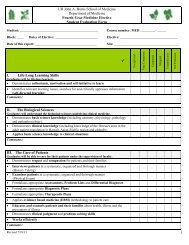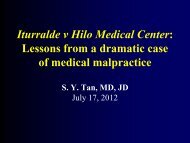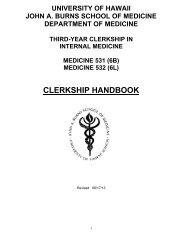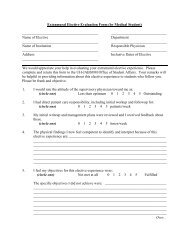- Page 1 and 2: UNIVERSITY OF HAWAII JOHN A. BURNS
- Page 3 and 4: CONTACT INFORMATION Clerkship Direc
- Page 5 and 6: TOP 10 WAYS TO EXCEL ON THE INTERNA
- Page 7 and 8: If a student does not follow these
- Page 9 and 10: Learning Objectives a. Training Pro
- Page 11 and 12: SUMMARY OF EVALUATION 1. Medical Kn
- Page 13 and 14: Medical Resident or Upper Level Res
- Page 15 and 16: e) After presenting the case, the s
- Page 17 and 18: Patient Assignment: The Ambulatory
- Page 19 and 20: Role Descriptions for Medicine 531/
- Page 21 and 22: student(s) assigned to the site. Th
- Page 23 and 24: ased health care that is patient fo
- Page 25 and 26: U.H. John A. Burns School of Medici
- Page 27 and 28: U.H. John A. Burns School of Medici
- Page 29 and 30: U.H. John A. Burns School of Medici
- Page 31 and 32: TEMPORARY PARKING PASS FOR THE CLIN
- Page 33 and 34: Special: Special is any patient tha
- Page 35 and 36: EVALUATION FORMS 35
- Page 37 and 38: 5. Obtains information for the othe
- Page 39: EYES: Test Visual acuity. Check eac
- Page 43 and 44: COMMON ERRORS OF THE BASIC PHYSICAL
- Page 45 and 46: Steps Done Not Done Seq. Incor . Te
- Page 47 and 48: Steps Done Not Done Seq. Incor . Te
- Page 49 and 50: U.H. John A. Burns School of Medici
- Page 51 and 52: U.H. John A. Burns School of Medici
- Page 53 and 54: Exceptional Very Competent Competen
- Page 55 and 56: UNIVERSITY OF HAWAII JOHN A. BURNS
- Page 57 and 58: U.H. John A. Burns School of Medici
- Page 59 and 60: Third-Year Clerkship in Internal Me
- Page 61 and 62: APPENDICES 61
- Page 63 and 64: TRAINING PROBLEMS LIST (continued)
- Page 65 and 66: 9. The impact of smoking on cardiov
- Page 67 and 68: 4. Recognize the importance of addr
- Page 69 and 70: • Location. (PC, CS) • Radiatio
- Page 71 and 72: Selecting various tests and procedu
- Page 73 and 74: 7. Principles of management of the
- Page 75 and 76: Ropper AH. (2005). Acute confusiona
- Page 77 and 78: 11. The meaning and utility of vari
- Page 79 and 80: Hoffbrand V. Provan D. ABC of clini
- Page 81 and 82: Bed rest. (MK) Exercise. (MK) Analg
- Page 83 and 84: setting. J Gen Intern Med. 2001;16:
- Page 85 and 86: Pulmonary hypertension/cor pulmonal
- Page 87 and 88: Pre-test and post-test likelihood o
- Page 89 and 90: Ability to communicate with patient
- Page 91 and 92:
Currie GP, Gray RD, McKay J. Chroni
- Page 93 and 94:
Anemia. (MK) Neuromuscular weakness
- Page 95 and 96:
of Internal Medicine. 16 th ed. New
- Page 97 and 98:
Dyspareunia. (PC, CS) Scrotal, test
- Page 99 and 100:
TRAINING PROBLEM #10: FEVER RATIONA
- Page 101 and 102:
Developing an appropriate evaluatio
- Page 103 and 104:
14. The types of fluid preparations
- Page 105 and 106:
Hauser SL, Longo DL, Jameson JL, ed
- Page 107 and 108:
Relevant past medical history. (PC,
- Page 109 and 110:
TRAINING PROBLEM #13: KNEE PAIN RAT
- Page 111 and 112:
5. Communication skills: Students s
- Page 113 and 114:
TRAINING PROBLEM #14: RASH RATIONAL
- Page 115 and 116:
Symptoms associated with the rash (
- Page 117 and 118:
TRAINING PROBLEM #15: UPPER RESPIRA
- Page 119 and 120:
Throat culture. (PC) Chest radiogra
- Page 121 and 122:
TRAINING PROBLEM #16: ACUTE MYOCARD
- Page 123 and 124:
esults of: Echocardiogram. (PC, MK)
- Page 125 and 126:
TRAINING PROBLEM #17: ACUTE RENAL F
- Page 127 and 128:
Anion gap. (PC, MK) ABG (PC, MK) Se
- Page 129 and 130:
TRAINING PROBLEM #18: COMMON CANCER
- Page 131 and 132:
Students should be able to define t
- Page 133 and 134:
TRAINING PROBLEM #19: COPD/OBSTRUCT
- Page 135 and 136:
Pulse oximitry. (PC, MK) ABG. (PC,
- Page 137 and 138:
TRAINING PROBLEM #20: DIABETES MELL
- Page 139 and 140:
24-hour urine for protein and creat
- Page 141 and 142:
TRAINING PROBLEM #21: DYSLIPIDEMIA
- Page 143 and 144:
Laboratory response to therapy. (PC
- Page 145 and 146:
fibrillation (MK) 11. Role of criti
- Page 147 and 148:
-Angoitensin receptor blockers. (PC
- Page 149 and 150:
TRAINING PROBLEM #23: HIV INFECTION
- Page 151 and 152:
Mental status examination. (PC) Fun
- Page 153 and 154:
D. REFERENCES: Guidelines for preve
- Page 155 and 156:
scientific evidence supporting each
- Page 157 and 158:
and the family. (P) 9. Recognize th
- Page 159 and 160:
TRAINING PROBLEM #25: LIVER DISEASE
- Page 161 and 162:
diagnosis and severity of disease,
- Page 163 and 164:
TRAINING PROBLEM #26: MAJOR DEPRESS
- Page 165 and 166:
Cranial CT. (PC, MK) Cranial MRI. (
- Page 167 and 168:
TRAINING PROBLEM #27: NOSOCOMIAL IN
- Page 169 and 170:
characteristics as well as patient
- Page 171 and 172:
TRAINING PROBLEM #28: OBESITY RATIO
- Page 173 and 174:
Accessing and utilizing appropriate
- Page 175 and 176:
The presence and quantification of
- Page 177 and 178:
www.cdc.gov/mmwr/PDF/RR/RR4608.pdf
- Page 179 and 180:
13. Typical clinical scenarios when
- Page 181 and 182:
treatment plan for patients that in
- Page 183 and 184:
future risk. (MK) 10. The indicatio
- Page 185 and 186:
TRAINING PROBLEM #32: SUBSTANCE ABU
- Page 187 and 188:
Determining when to obtain consulta
- Page 189 and 190:
MI/unstable angina. (MK) Congestive
- Page 191 and 192:
eing, ability to work, and the fami
- Page 193 and 194:
8. Communicating the prioritized di
- Page 195 and 196:
A diagnostic and treatment plan for
- Page 197 and 198:
GENERAL CLINICAL CORE COMPETENCIES
- Page 199 and 200:
McGee SR. Evidence-Based Physical D
- Page 201 and 202:
1. Demonstrating appropriate listen
- Page 203 and 204:
GENERAL CLINICAL CORE COMPETENCIES
- Page 205 and 206:
Pulmonary edema/“congestive heart
- Page 207 and 208:
#6 THERAPEUTIC DECISION MAKING GENE
- Page 209 and 210:
consent and advance directives. Add
- Page 211 and 212:
#8 SELF-DIRECTED LEARNING GENERAL C
- Page 213 and 214:
treatment of disease but also the r
- Page 215 and 216:
#10 COORDINATION OF CARE GENERAL CL
- Page 217 and 218:
GENERAL CLINICAL CORE COMPETENCIES
- Page 219 and 220:
6. Demonstrate ongoing commitment t
- Page 221 and 222:
1. Obtaining informed consent, when
- Page 223 and 224:
malnutrition (e.g. alopecia, ecchym
- Page 225 and 226:
#14 COMMUNITY HEALTH CARE GENERAL C
- Page 227 and 228:
GENERAL CLINICAL CORE COMPETENCIES
- Page 229 and 230:
www.ihi.org/ihi Crossing the Qualit
- Page 231 and 232:
5. Determining when to obtain consu
- Page 233 and 234:
1. Participating in obtaining infor
- Page 235 and 236:
November 27, 2003 Volume 8 Issue 24
- Page 237 and 238:
PTU propylthiouracil Mistaken as me
- Page 239 and 240:
Example of Inpatient History and Ph
- Page 241 and 242:
changes, retention, incontinence; h
- Page 243 and 244:
hemorrhage is usually caused by ero
- Page 245 and 246:
completely avoid NSAIDs but still p
- Page 247 and 248:
A: While the differential diagnosis
- Page 249 and 250:
Problem #2: Hypertension S. No ches
- Page 251 and 252:
CLINICAL SKILLS EXAMINATION (CSE) S
- Page 253 and 254:
PAGERS/CELLULAR PHONES Cellular pho
- Page 255 and 256:
JOHN DOE -- PATIENT NOTE EXAMINEE I
- Page 257 and 258:
MEDICINE General Principles 1%-5% O
- Page 259 and 260:
8. A 20-year-old African American w
- Page 261 and 262:
19. A 32-year-old man comes to the
- Page 263:
Answer Key for Medicine Subject Tes






